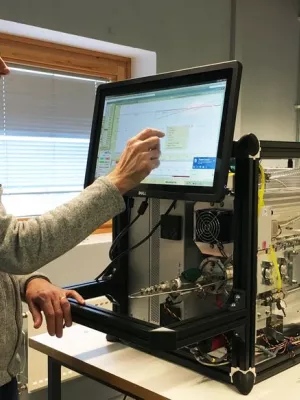
Erik Swietlicki
Professor

Aerosol indirect effects on continental low-level clouds over Sweden and Finland
Författare
Summary, in English
Aerosol effects on low-level clouds over the Nordic Countries are investigated by combining in situ ground-based aerosol measurements with remote sensing data of clouds and precipitation. Ten years of number size distribution data from two aerosol measurement stations (Vavihill, Sweden and Hyytiälä, Finland) provide aerosol number concentrations in the atmospheric boundary layer. This is combined with cloud satellite data from the Moderate Resolution Imaging Spectroradiometer and weather radar data from the Baltic Sea Experiment. Also, how the meteorological conditions affect the clouds is investigated using reanalysis data from the European Centre for Medium-Range Weather Forecasts.
The cloud droplet effective radius is found to decrease when the aerosol number concentration increases, while the cloud optical thickness does not vary with boundary layer aerosol number concentrations. Furthermore, the aerosol–cloud interaction parameter (ACI), a measure of how the effective radius is influenced by the number concentration of cloud active particles, is found to be somewhere between 0.10 and 0.18 and the magnitude of the ACI is greatest when the number concentration of particles with a diameter larger than 130 nm is used. Lower precipitation intensity in the weather radar images is associated with higher aerosol number concentrations. In addition, at Hyytiälä the particle number concentrations is generally higher for non-precipitating cases than for precipitating cases. The apparent absence of the first indirect effect of aerosols on low-level clouds over land raises questions regarding the magnitude of the indirect aerosol radiative forcing.
The cloud droplet effective radius is found to decrease when the aerosol number concentration increases, while the cloud optical thickness does not vary with boundary layer aerosol number concentrations. Furthermore, the aerosol–cloud interaction parameter (ACI), a measure of how the effective radius is influenced by the number concentration of cloud active particles, is found to be somewhere between 0.10 and 0.18 and the magnitude of the ACI is greatest when the number concentration of particles with a diameter larger than 130 nm is used. Lower precipitation intensity in the weather radar images is associated with higher aerosol number concentrations. In addition, at Hyytiälä the particle number concentrations is generally higher for non-precipitating cases than for precipitating cases. The apparent absence of the first indirect effect of aerosols on low-level clouds over land raises questions regarding the magnitude of the indirect aerosol radiative forcing.
Avdelning/ar
- Kärnfysik
- MERGE: ModElling the Regional and Global Earth system
Publiceringsår
2014
Språk
Engelska
Sidor
12167-12179
Publikation/Tidskrift/Serie
Atmospheric Chemistry and Physics
Volym
14
Issue
22
Länkar
Dokumenttyp
Artikel i tidskrift
Förlag
Copernicus GmbH
Ämne
- Subatomic Physics
Status
Published
ISBN/ISSN/Övrigt
- ISSN: 1680-7324